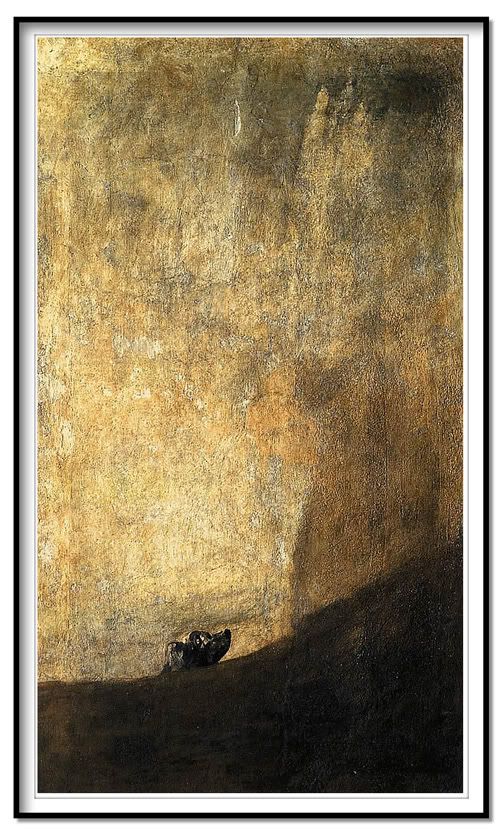It's a haunting picture don't you think? But what is it about? Why did he paint it? And why is it so powerful? These are the questions we will try and answer in our first (of many I hope!) Art Classes. Ladies and Gentlemen welcome to Goya's 'The Dog'.
Its power lies in it's simplicity. There's nothing much there. Minimal. Never was minimal so maximal. This painting is a part of a whole series of paintings he did collectively known as his 'black paintings' and the artist painted it on the walls of his home, the Quinta del Sordo, outside Madrid. He painted it (with the other black paintings) on the walls of his home, because they were for him. They were never meant to be seen by the outside world. These black paintings were the equivalent of a personal diary entry. After Goya's death the murals were detached from the wall; his home demolished, and they ended up (luckily for us) in the Prado Museum - where they remain to this day. Of all the black paintings, for me the dog, is of the very worst. The fact that the paint was flaking before they were removed seems to exacerbate the poor animals misfortune.
Where are we? Who knows. Because the scene is so minimal and non-specific. First, there is the shape of the whole picture, an exceptionally tall narrow upright oblong – indeed perversely tall, narrow and upright, considering that the scene is, after all, a kind of landscape. Secondly, there is the ratio of the areas within it: the upper area very deep, the lower area very shallow. These extreme proportions have an inherent drama. Whatever finds itself in the lower area is right down at the bottom of the vertiginous scene, as if it was at the bottom of a well or a cliff, or despair. The conceit works well.
OK, now let's talk about the dog...
But of course we only see the head of the dog, poking into the upper area, its body in some way obscured by the lower one. It raises a snout hopefully. It has a most pathetic, anxious look in its eye. It gazes up, in the direction of the rising edge. And the uncertainties and proportions of the scene all fall upon it. You can see the creature as submerged in the lower area, up to its neck in it, buried in the ground. It raises its head, trying to keep itself "above water". But the great empty gulf that towers above it only emphasises its helplessness. Alternatively, you can see the dog as cowering behind a ridge, trying to hide and protect itself. It raises its head in trepidation, looking up at the impending danger from above. Either way, it is a picture about bare survival in the face of hopeless doom. Whether the danger comes from below or from above, the picture tells us there is no escape. There is no way out of the drowning mire. And the fact that we see only the dog's head, and nothing of its body and limbs, further reduces its chances of escape. It is deprived of any sense of movement or action. It is only a head, a consciousness, lost in a universe of terrors, afraid for its life - nobody cares. The universe is indifferent. Just like us perhaps? Who knows what Goya is saying. It's all a mystery. No it's not. It's clear to me what Goya is saying. I know exactly what Goya is saying cos we're like brothers! I love this painting. It speaks to me in ways words cannot.
